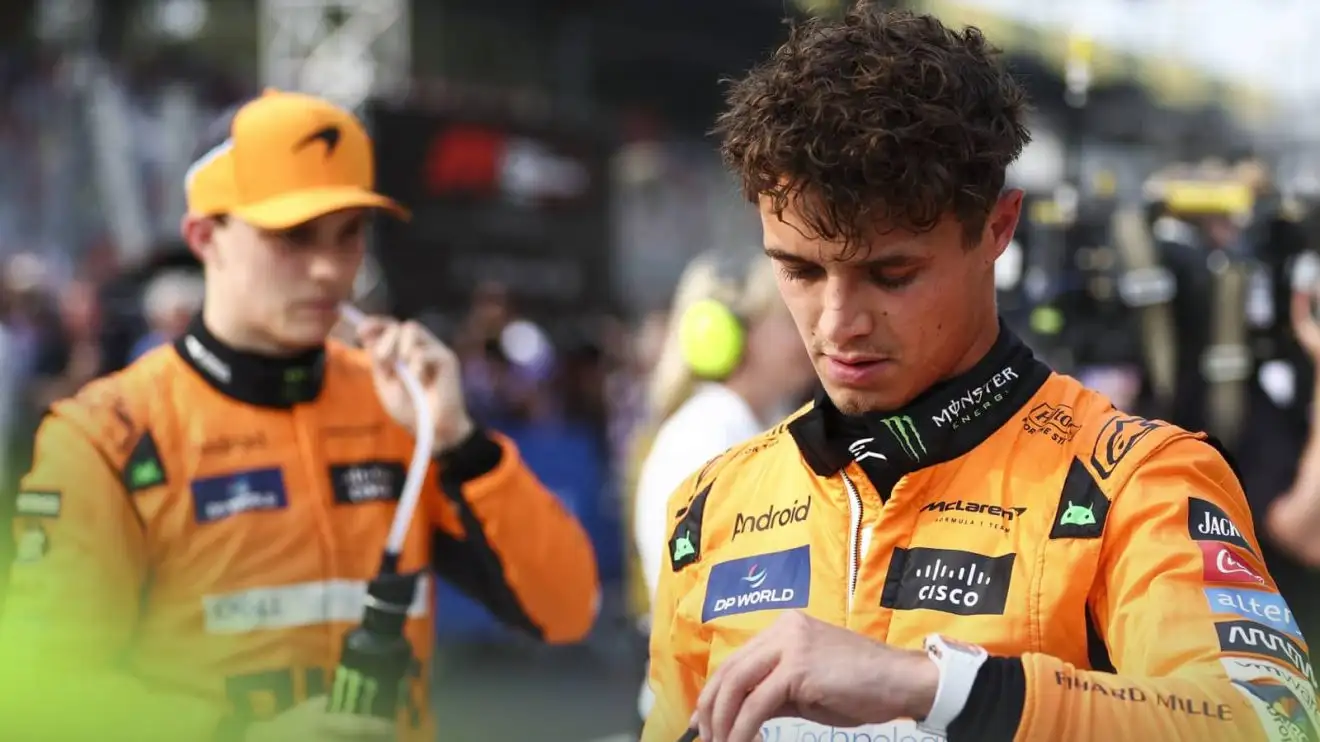In the high-octane world of Formula 1, where milliseconds separate victory from defeat, the most dangerous battles are often fought not on the track, but within the team garage. For McLaren, a team tasting championship glory for the first time in years, this internal conflict has reached a terrifying boiling point. The relationship between their two star drivers, championship leader Oscar Piastri and the hugely popular Lando Norris, has completely fractured. What began as simmering frustration has erupted into a full-blown crisis, with Piastri and his formidable manager, Mark Webber, reportedly threatening to walk away from the team in a move that could send shockwaves through the entire sport.

The flashpoint, visible to millions around the world, occurred under the dazzling lights of the Singapore Grand Prix. At the very first turn, the two papaya-colored cars made contact. While racing incidents between teammates are not uncommon, it was the raw emotion in Piastri’s voice over the team radio that revealed the deep cracks in the foundation of McLaren’s unity. “That wasn’t very team-like, but sure,” he stated, his words dripping with a mix of sarcasm and profound disappointment. This single sentence was not an outburst in the heat of the moment; it was the culmination of months of perceived slights, inconsistent management, and a growing sense that the scales of justice within the team were unfairly tipped. Singapore was not the cause of the problem; it was merely the stage where the private drama became a public spectacle.
Now, as the Formula 1 circus prepares for the United States Grand Prix in Austin, Texas, the situation has escalated from a serious issue to a potential catastrophe for McLaren. Behind the scenes, Mark Webber, a man who knows all too well the bitter taste of intra-team politics from his own turbulent years at Red Bull Racing, is waging a quiet war. Sources close to the camp suggest that Webber is not just comforting his young charge; he is actively exploring exit strategies, using the very real threat of Piastri’s departure as a powerful bargaining chip. The demand is simple and brutal: McLaren must make a choice and publicly back Oscar Piastri as their number one driver for the championship run-in.
The timing of this ultimatum could not be more critical. The US Grand Prix is a sprint weekend, a format that crams four high-pressure competitive sessions into three days. A sprint qualifying, a sprint race, main qualifying, and the Grand Prix itself—each session is another potential arena for conflict, another opportunity for the two drivers to clash. With Piastri holding a 22-point lead over Norris in the Drivers’ Championship, the advantage seems comfortable, but it’s a fragile buffer. A staggering 199 points are still available in the final six races of the season, and with three of those being sprint weekends—Austin, Mexico, and Brazil—the championship could swing dramatically in a single afternoon.

Mark Webber’s involvement transforms this from a standard teammate rivalry into something far more volatile. His own history in the sport is a scar that has never fully healed. During his tenure at Red Bull, he frequently felt that he was playing second fiddle to the team’s golden boy, Sebastian Vettel, despite being a multiple race winner himself. This personal experience has made him hyper-vigilant to any sign that Piastri is not receiving the equal and fair treatment he was promised. He sees the echoes of his own past in Piastri’s present and is determined to prevent history from repeating itself.
Webber is not making idle threats. Reports are swirling that he has already engaged in preliminary discussions with several rival teams, testing the waters for a potential 2027 move for his driver. While Ferrari has been mentioned as a possible destination, the names of Red Bull and Aston Martin have also entered the conversation. Webber is playing a high-stakes game of political chess, leveraging Piastri’s immense talent and championship position to force McLaren’s hand. He has a reputation for being fiercely protective of his drivers, and the paddock knows he is a man who will make bold, decisive moves to safeguard their careers.
The pressure on McLaren is not just internal; it is coming from all directions. Respected figures in the Formula 1 community have begun to weigh in, amplifying the scrutiny on the Woking-based team. Former Haas team principal Guenther Steiner has publicly stated that McLaren must logically back Piastri, the driver with the points advantage. Racing legend Mario Andretti has openly suggested that the team appears to be favoring Norris, a sentiment that fuels the narrative of bias. Even Aston Martin’s Lawrence Stroll has opined that McLaren needs to stop trying to please everyone and make a definitive choice.

This leaves McLaren in an utterly impossible position. On one hand, they cannot afford to lose Oscar Piastri. He is leading the world championship, has proven himself to be one of the most remarkable talents of his generation, and represents the future. Losing him would be a catastrophic failure. On the other hand, they cannot risk alienating Lando Norris. He is a British driver in a British team, incredibly popular with the global fanbase, and has been a loyal servant to McLaren for years, sticking with them through difficult times. He is the heart of the team in many ways.
The team’s internal guidelines, the so-called “Papaya rules,” were designed to manage this exact scenario, ensuring fair play and equal opportunity. But under the intense pressure of a championship fight, these rules have failed spectacularly. In the wake of the Singapore incident, reports now suggest that McLaren has abandoned them entirely, opting for a “gloves-off” approach where the drivers are free to race without team intervention. While this may seem like a solution, it is a dangerous gamble. Without any established rules of engagement, the likelihood of another on-track collision increases exponentially, a scenario that could see both of their championship hopes evaporate in a cloud of carbon fiber.
The Circuit of the Americas in Austin is a particularly challenging venue for this new, high-risk strategy. The track’s iconic long, uphill run into the tight Turn 1 is a prime overtaking spot where aggression is rewarded, but misjudgment can lead to disaster. With multiple heavy braking zones and a technical, high-speed sector, the opportunities for conflict are numerous. Add the inherently aggressive nature of a sprint race, where drivers have less time to make their moves, and you have the perfect recipe for drama.

Lurking in the shadows of this internal McLaren implosion is Max Verstappen. The Red Bull driver sits third in the championship, 63 points behind Piastri. While this gap is significant, Verstappen’s recent form has been formidable, and a collision or poor result for the McLaren duo could bring him right back into contention. The ultimate irony for McLaren would be for their internal civil war to become so destructive that it hands the world championship title to their fiercest rival.
The demands from the Piastri and Webber camp are crystal clear: they want public and unequivocal backing from the team. They want preferential treatment in strategy calls, reflecting Piastri’s status as the championship leader. They want a guarantee that Piastri will not be asked to sacrifice his position for Norris. In essence, they want McLaren to officially designate him as the number one driver. For a team that has long prided itself on equality, this is a bitter pill to swallow.
As the teams set up in Austin, the stakes could not be higher. This weekend will be a true test of McLaren’s crisis management. It will reveal whether their new hands-off approach can work or if it will only pour gasoline on an already raging fire. The threat from Piastri and Webber is not a bluff. It is a genuine reflection of their unhappiness and a clear signal that they are prepared to seek a future elsewhere if their concerns are not addressed. The coming races will not only decide the fate of the 2025 championship but will also determine the very future of the McLaren team and its driver lineup. The papaya-colored dream is on the verge of becoming a nightmare.






